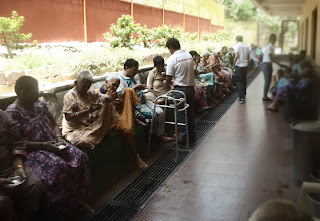River Godavari at Nashik
At 30km from the Nashik city, River Godavari originates from Brahmagiri Hills at Trimbakeshwar. The hill is part of the long-running chain of the Western Ghats. I reached the city at 4:30 AM in the morning. It was cold and the streets were empty. The place where the ghats of Godavari are situated is called Panchvati. It is also considered as the old Nashik. Getting down from the bus, with the help of Google Maps, I walked towards it. At Pune, I have severally regretted to not have seen older wooden houses & the ones that I saw were in shambles. However, while I was heralding thru the streets of Nashik, I passed thru many such old houses in good conditions.
Nashik is also a place where Kumbh Mela is celebrated every 12 years. Since I had a chance to visit Haridwar recently, I was contrasting my visit at Nashik with it. As soon as I reached the ghat, I wanted to take the holy dip at the river. At Nashik, Godavari is secondarily referred to as Gange! So, I had my excitement with me, later only to be diminished by the condition of it. Because of its proximity to the origin point, I had expected a crystal clear water with breathtaking ecological views. The reality was different. Like all over India, in here too the river is open for drainage from untreated sewage wastes and the industrial discharge without any discrimination. The color of the water seemed blackish and it was having a strange odor. The volume of the river was bare minimum to maintain a flow at it.
 Sadly, I put my luggage besides me and sat over one of the staircases of the Goddess Godavari temple. It was already clocking 5 AM and I could see few people coming to the ghats. The sky was still dark and the air Foggy. I was speechless. With time, people started to flock the ghats and without any hesitation entering the water to take the holy dip. They were sincere and dedicatedly reciting the chants of the Gods. People would drink the water and carry it to their home for sacred usages. The science behind the side effects of the river pollution is easily scrapped before the serious religious rigour. River is being used for performing several ritual ceremonies attached with the Hinduism.
Sadly, I put my luggage besides me and sat over one of the staircases of the Goddess Godavari temple. It was already clocking 5 AM and I could see few people coming to the ghats. The sky was still dark and the air Foggy. I was speechless. With time, people started to flock the ghats and without any hesitation entering the water to take the holy dip. They were sincere and dedicatedly reciting the chants of the Gods. People would drink the water and carry it to their home for sacred usages. The science behind the side effects of the river pollution is easily scrapped before the serious religious rigour. River is being used for performing several ritual ceremonies attached with the Hinduism.Like other religious places, Godavari ghats offer economic affluence and livelihood to thousands of locals. Around a well-developed ghat, there would be the opportunity to sell flowers, offerings, ritual items, and so on as we normally encounter. There would be lodgings & food courts. People would differently opt for various services available in the city. Also, at places such as this where thousands of lower & middle-class people congregate, we understand the importance of trust-based Dharamshalas. People travel from far North & far South to visit here and also to Trimbakeshwar, where one of the 12 jyotirlingas is situated. This place is associated with the tales of Ramayana for which it holds great importance as a pilgrimage site. As the sun rose to the sky, the Ghat was already hustling and living with a healthy crowd.
From what I saw is that a new construction project is in progress and it will diverge the waste drainage towards outside the city, although at last in the river itself. But even with this, the common people would benefit in many ways... At another end, some rejuvenation work was going on, maybe as part of the smart city project that the new Nashik is already be. I walked a distance along with my luggage on my shoulder to see many old-looking statues before retiring in a Dharamshala in one of the nearby streets. My heart was heavy to not have taken the dip. Har Har Godavari, Har Har Gange!



Must be a good experience.
ReplyDeleteAbsolutely
Delete